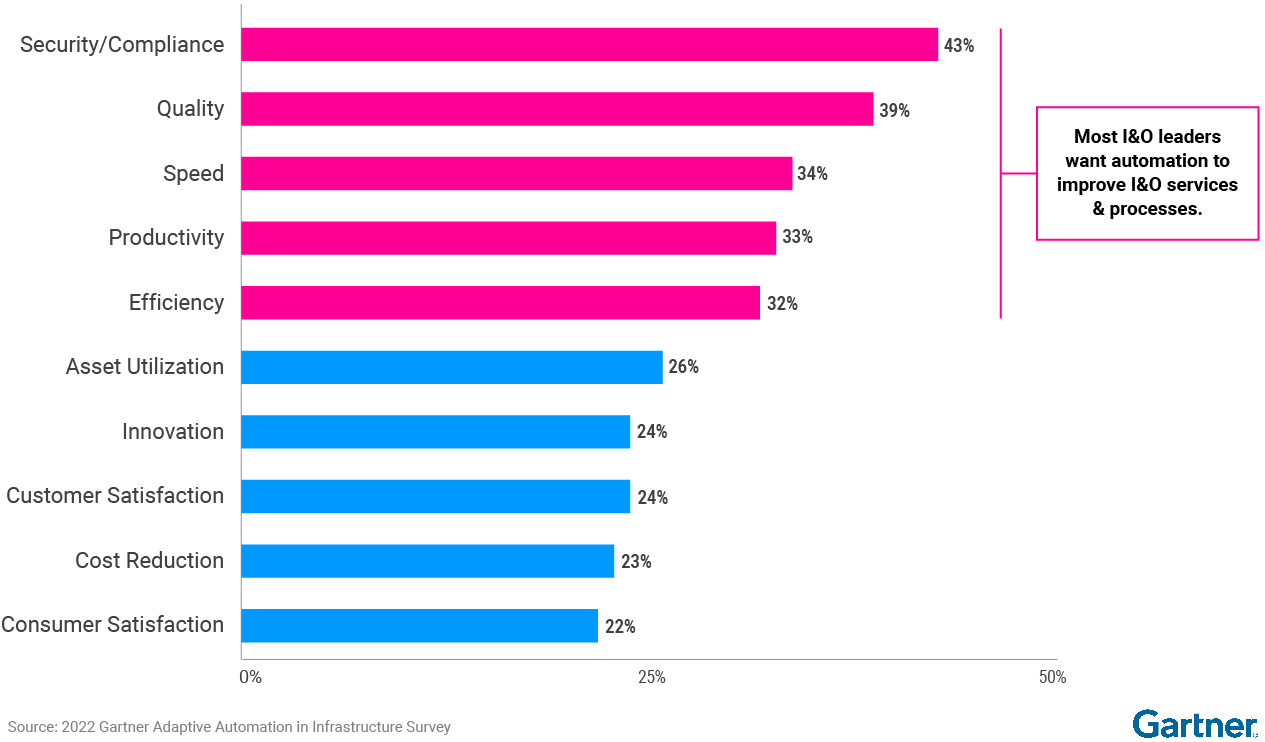As business environments continue to change and evolve, infrastructure delivery must also evolve to support.
Networks and IT infrastructure are increasingly mission-critical for how businesses operate today. Priorities like application development and innovation, cloud migration, and cybersecurity have placed greater focus on how an organization’s network and infrastructure supports the business.
I&O leaders want automation to improve service delivery and process time, yet are only marginally realizing any gains. For instance, developers can be moving as fast as they want, security teams can be rapidly updating policies, but if it takes multiple days for the network to fulfill a change request, the end-to-end business processes are still going to take time. Not to mention, increased pressures from security, compliance, and cost perspectives require teams to react faster across hybrid infrastructure — a significant challenge due to lagging skills adoption and increasing network complexity.
Most leaders have struggled to realize benefits and scale automation initiatives, or even understand what automation means for them. Whether your team has some existing, piecemeal automation or is starting from scratch, it’s important to understand how to define and track value for your unique business. The following Gartner survey data highlights key business value drivers I&O leaders are looking for from network and infrastructure automation:
Many Automation Goals
% Selecting Goal as Top 3 Aspiration

To realize these benefits, organizations are adopting new solutions and strategies to extend automation and enable network teams to accelerate without increasing cognitive load. By 2025, 70% of organizations will complement the continuous delivery of applications with continuous infrastructure automation to improve business agility, which is a significant increase from fewer than 20% in 2021.
Leaders are looking for solutions that will transform and accelerate networking to support the needs of agile business while ensuring quality, security, and compliance across hybrid network infrastructure.
How Automation Can Deliver Key Business Benefits
Productivity & Efficiency
Successful network automation will empower network engineers to do more with less effort and enable the business to avoid costly tool sprawl, retraining, or significant headcount increases. Automating as many tasks as possible allows network leaders to allocate resources to higher-value strategic activities.
Example:
Network engineers spend a significant amount of time manually performing change management and/or ticket management activities. A solution that enables teams to automate these activities can drastically increase productivity, allowing the network team to scale to support the needs of the business without increasing headcount or workload.

How RUSH automated NetOps to respond quickly to critical IT needs and on-demand patient care.
Listen to the story
How a major US airline reduced time to upgrade device OS from 4 months to 4 hours for over 3500 devices.
Read the story
How a global manufacturer orchestrated software deployments for new employees, saving 834 hours of manual work while reducing time between service request and delivery.
Read the story
Speed
Enterprise networks must be able to support the speed of application development and adoption of new technologies by delivering services faster. Developers are accustomed to instant self-service for public cloud services — if traditional network and IT infrastructure can accelerate to match, time to revenue will be reduced across the business.
Example:
Reducing time to complete from network service request to fulfillment is a direct value driver. Accelerating that process impacts user experience for network consumers such as security teams and application developers, allowing them to move faster and making a difference for business processes outside of networking teams.

How a multinational biotech company accelerated service delivery by orchestrating workflows for standard network changes and delivering them for end users to self-serve.
Read the story
Fiserv’s automation journey and how they adopted orchestration and integration to accelerate the delivery of network engineering across the business.
Listen to the story
Quality
Service quality and network uptime are vital to ensuring enterprise networks can reliably and cost-effectively support key business objectives. Automation can allow teams to test changes more completely and introduces standardization, improving internal controls and ensuring automated services can be delivered with confidence.
Example:
Automating testing and validation for network changes removes time constraints that can lead to testing being neglected and actually allows teams to run more comprehensive validation than they would manually, improving service quality and directly impacting user experience for both internal and external consumers of network services.

How Deutsche Telekom automated checks, validations, and execution of software upgrades to minimize errors and ensure service quality.
Listen to the story
How a digital payments provider integrated networking with change management to ensure quality and enable process auditing while accelerating time to provision new services.
Read the story
Compliance & Security
The cost of network downtime, security vulnerabilities, and errors will only continue to increase. However, network teams are facing growing difficulties managing compliance and security due to the complexity of network infrastructure. If teams can leverage a single automation platform to manage compliance across all domains, businesses can continue to expand and innovate with confidence.
Example:
Configuration drift, where network device configurations fall out of date due to backlog, creates security vulnerabilities and impacts service quality—but it is often considered a low priority. Automation can solve challenges that teams are unable to take on due to manual workloads that meaningfully impact the business by reducing risk and lowering potential costs.

How a leading health insurance provider centralized and accelerated configuration management for both CLI devices and API services, mitigating compliance risk.
Read the story
How a global financial services company implemented blocking as a service by integrating with multiple SOAR vendors and orchestrating threat response workflows to immediately block flagged entities across complex, multi-domain network infrastructure.
Read the story
Innovation
Ultimately, what leaders and organizations are looking for network automation to deliver is the ability for the entire organization to innovate and stay ahead. We’ve all been paying close attention to AI, and who knows what’s next on the horizon? Network automation can transform networks to support rapid adoption of new technology across the business and give application developers the flexibility and freedom to innovate.
Example:
Application development is one of the primary areas for innovation in enterprise. To test their code across the full range of infrastructure the business utilizes, developers require network services that are delivered rapidly and securely. Network automation can directly impact business by scaling application development and allowing developers to move as quickly as they can.

How S&P Global orchestrated network services across multiple clouds and delivered services for application developers to self-serve, accelerating application delivery across hybrid multi-cloud infrastructure.
Read the story
How Lumen drove business transformation and scaled to support business agility with automation and orchestration.
Read the story
We have a proven track record of working with the world’s largest, most complex enterprises and service providers, delivering value by helping organizations realize the business impact of network automation. Explore our real-world customer stories here to see why teams choose to automate and orchestrate with Itential.





